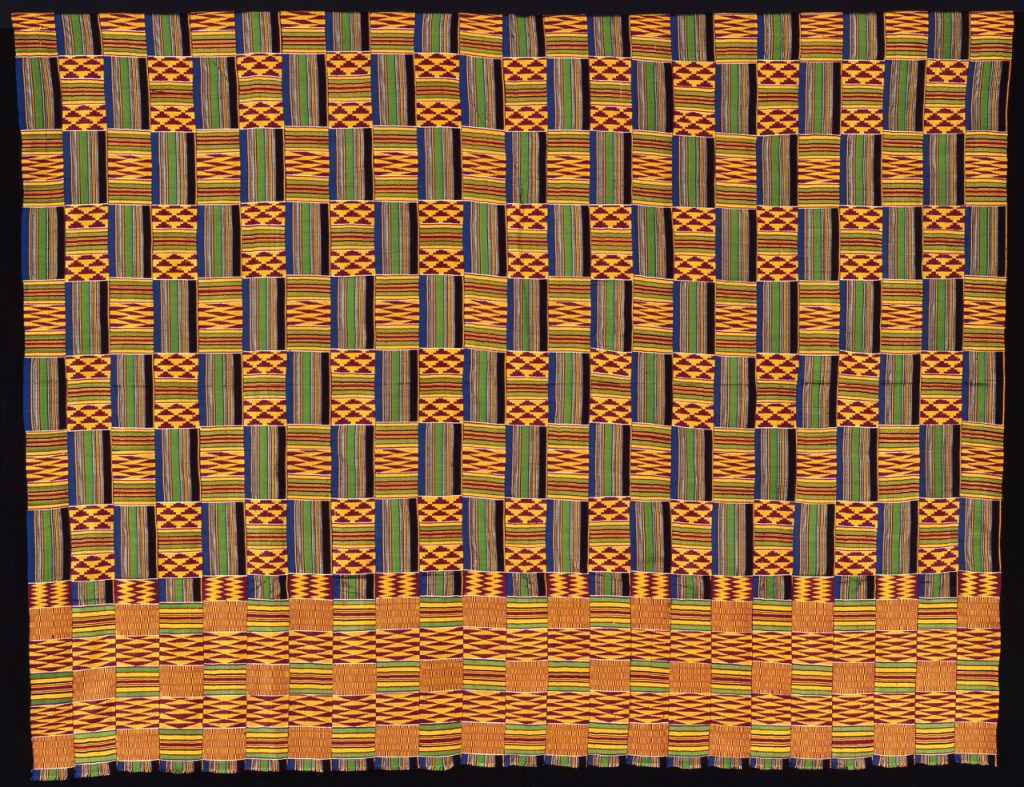Tela de hombre en el patrón Darkoro Yesre ("Ciertamente un día reirás") (obra de arte)
Información sobre la obra de arte
Key Ideas
- This is a kente cloth. It symbolizes African unity and heritage.
- This colorful, patterned cloth is traditionally hand-woven by men in Ghana. They weave this textile in long thin strips and then sew the strips together to form large pieces of cloth.
- Kente cloth is worn by leaders throughout Africa and by people of African heritage worldwide. It is often worn on special occasions.
- The colors and patterns woven into a kente cloth have symbolic meanings. There are hundreds of different patterns. Each one is named by the master weaver who created it.
- The Ghanaian textile artist who created this kente cloth is known for his intricately woven fabrics.
Más información
Kente cloth is a textile that originated in Ghana, West Africa, centuries ago. This silk-and-cotton, colorfully patterned cloth is woven by hand. It is traditionally created and worn by men. Kente cloth represents the culture of Ghana, and it is a symbol of African unity and heritage. Kente cloths are often family heirlooms that are passed down from one generation to another.
The finest, most intricate kente cloths were once reserved for Akan and Asante royalty. Today kente cloth is worn by people throughout Africa and the West. African leaders wear kente cloths as part of their official dress. People of African heritage in the United States wear kente cloths on special occasions like weddings, graduation ceremonies, and holidays, to honor and connect with their origins.
Kente cloth is named for the specific patterns that are woven into the fabric. The patterns can represent deep meanings relating to a person’s achievement, morals, and values. The vibrant colors of the threads are also symbolic. Thread colors represent things like growth, renewal, peace, and serenity. The main thread colors in this particular kente cloth are blue, gold, green, red, and black. These colors have special meaning for both the maker and the person who wore it.
There are hundreds of different patterns of kente cloth. Each pattern is named by the master weaver who created it. This kente cloth was created by Opanyin James Osei Kwaku Antobreh, a prominent textile artist in Ghana. He is known for creating intricately woven fabrics. The name he gave this pattern includes the adage, or traditional saying, darkoro yesre. It means “certainly one day you will laugh.” This phrase reminds the wearer of better days ahead.
tags: patrón, comunicación, poder, orden, función
Recursos adicionales
Recursos para los profesores
- Read an article about the history of kente cloth.
- Explore a classroom activity that combines weaving and math.
- Read an article about textile art in West Africa.
Recursos para los estudiantes
- Watch a video of Ghanaian weavers making kente cloth.
- Read an article about kente cloth patterns and meanings.
- Visit a website that includes a video on how to weave a kente cloth using paper.

